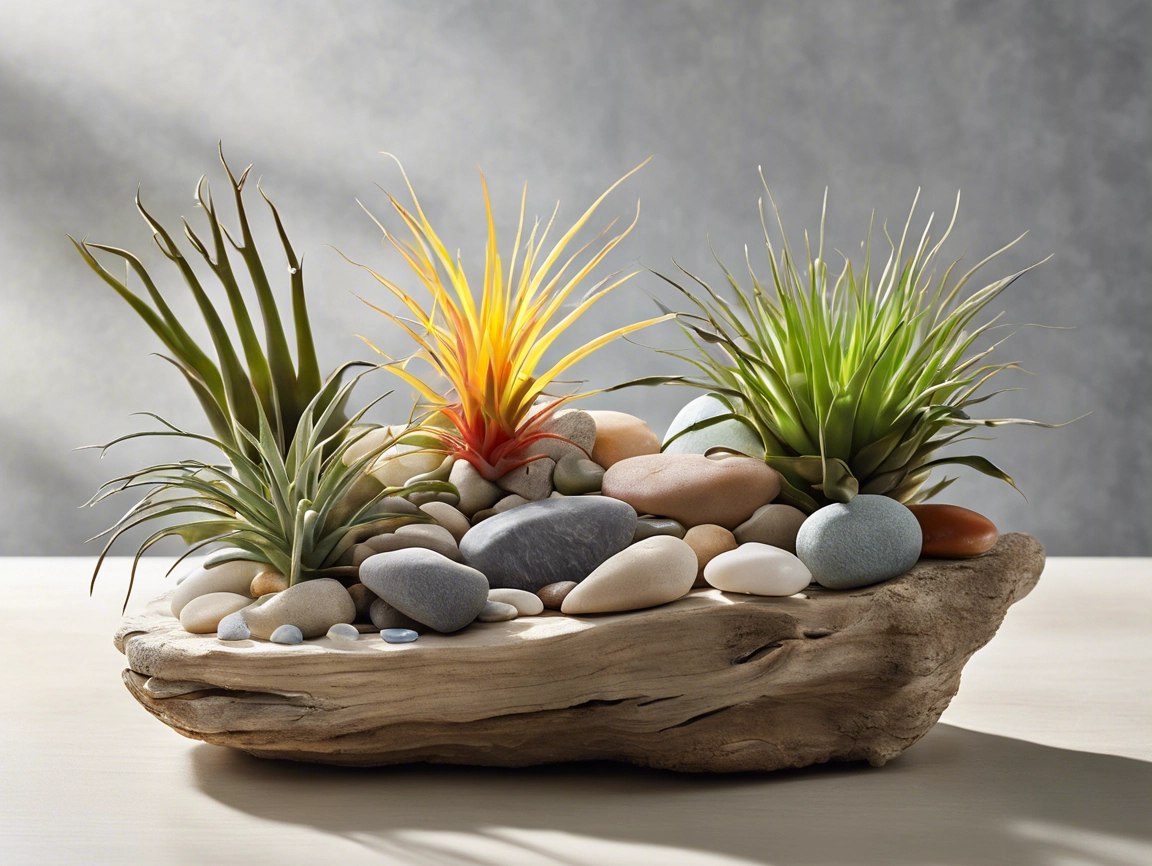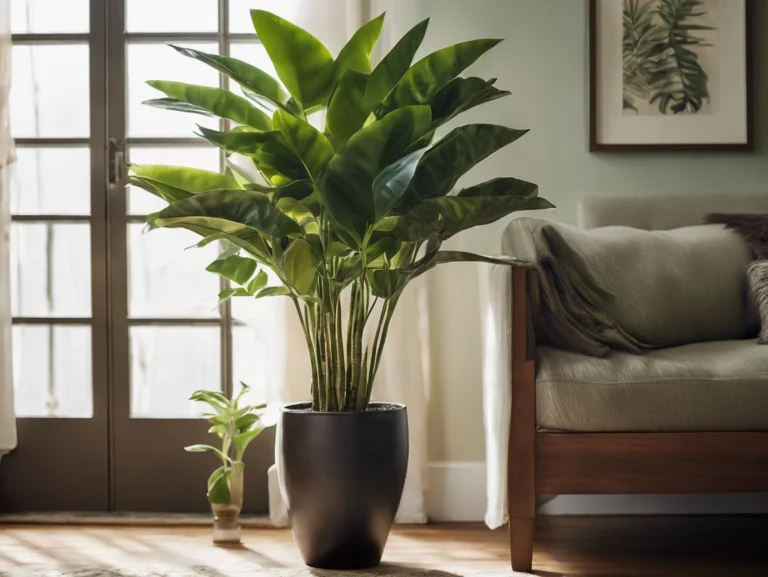How To Care For Air Plants
Explore the fascinating world of air plants, also known as Tillandsia. Learn how to care for these unique plants to keep them healthy at home. Air plants are special because they don’t need soil. They get their nutrients and moisture from the air.
Whether you’re new to plants or have experience, this guide will help you. You’ll learn how to grow vibrant air plants.
These plants live on surfaces like trees and rocks. They’ve adapted to grow in different places. By understanding their natural habitat, you can create the best conditions for them indoors.
There are many Tillandsia species. Each one has its own way of surviving and growing in its native home.
Table of Contents
Understanding Air Plants and Their Natural Habitat
Tillandsia, or air plants, are a unique group of plants. They belong to the bromeliad family. These plants are adapted to live in dry places and don’t need soil to survive.
Types of Tillandsia Species
The Tillandsia genus includes many different air plant varieties. Each has its own look and way of growing. For example, the Tillandsia usneoides looks like Spanish moss, while the Tillandsia ionantha is colorful and sculptural.
Natural Growth Patterns in the Wild
In their natural homes, like tropical forests, air plants grow on tree branches. They use their roots to hold onto the bark. This way, they get the light and nutrients they need without competing with other plants.
Adaptation Mechanisms of Epiphytes
One of the main ways air plants survive is by absorbing moisture and nutrients from the air. Their leaves have tiny hairs that help keep water in. This lets Tillandsia stay healthy in dry environments.
Essential Requirements for Growing Air Plants Indoors
To grow thriving air plants, or Tillandsia, at home, you need to know their special needs. These plants live on air, light, and a little water. They’re perfect for indoor gardens. Here’s what you need to create a great space for them:
Optimal Lighting Conditions
Air plants need lots of indirect sunlight to grow well. Put them by a bright, south-facing window or use indoor air plant lights. But, don’t let them get too much direct sunlight, as it can burn their leaves.
Proper Air Circulation
Good air movement is key for air plant care indoors. Tillandsia need air to get moisture and nutrients from the air. Use a soft fan or put them near a window for air flow.
Moderate Temperature and Humidity
Tillandsia like warm, humid places, like their natural homes. Keep the temperature between 60-85°F and the humidity at 40-60%. Mist them often to keep them moist and prevent dryness.
Infrequent but Thorough Watering
Water air plants less than regular houseplants. Soak them in water for 10-15 minutes once a week. Let them dry completely before putting them back. Don’t let water stay in the plant’s center, as it can cause rot.
With the right light, air, temperature, and water, your indoor air plants will do great. They’re easy to care for and add beauty to your home. With a bit of care, they’ll show off their unique charm.
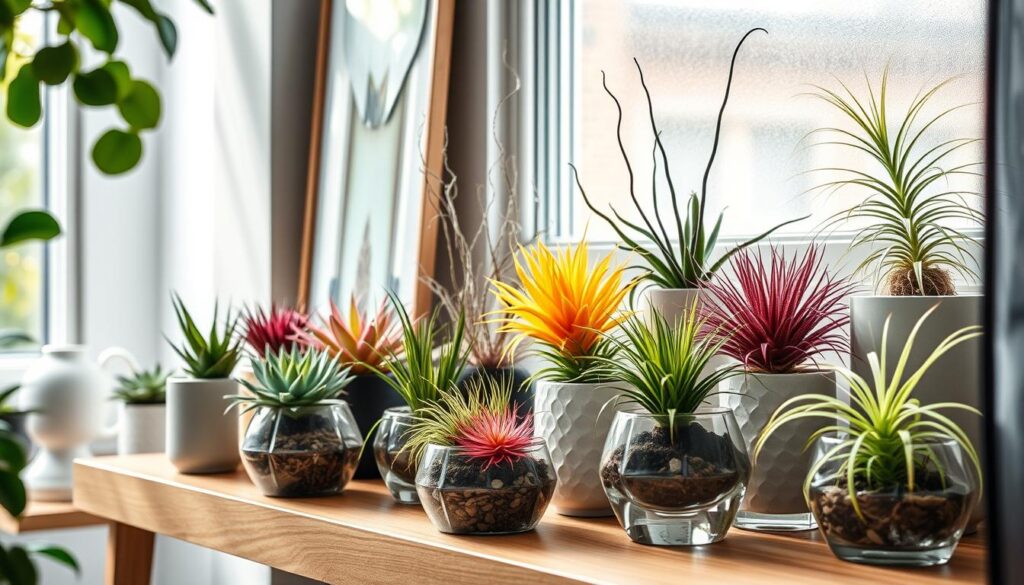
Watering Techniques for Healthy Air Plants
Caring for air plants, or Tillandsia, needs a careful touch when watering. Learning how to water right is key to keeping your air plants healthy. We’ll look at misting and soaking, and how to choose the right water and temperature for your Tillandsia.
Misting vs. Soaking Methods
Air plants get moisture through their leaves, not roots. So, they need a light misting a few times a week. This keeps them hydrated like their natural home. Or, you can soak them in water for 10-15 minutes every 1-2 weeks. This gives them a deeper drink when they’re really dry.
Water Quality and Temperature Guidelines
The water you use matters a lot for your air plants. Use purified, distilled, or filtered water to avoid minerals and chemicals. Also, keep the water at a lukewarm temperature, around 70-85°F (21-29°C). This is close to their ideal growing spot.
Signs of Over and Under-Watering
- Overwatering: Leaves turn brown or black, look water-logged, and might rot.
- Underwatering: Leaves curl in, turn grey or brown, and get brittle.
Watch your air plants closely and adjust your watering as needed. This way, you’ll keep them growing strong and healthy.
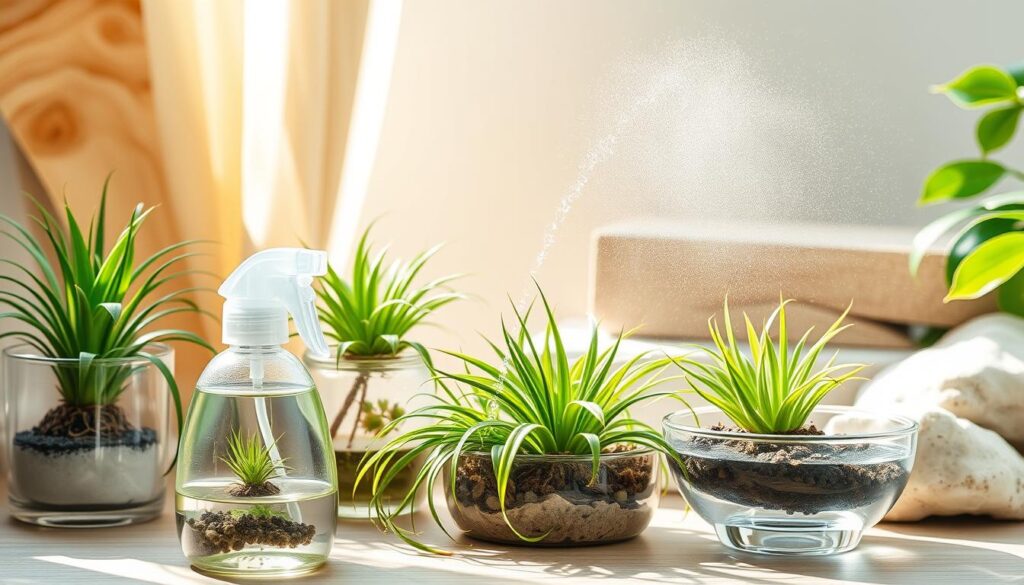
“Proper watering is the key to a thriving air plant collection. Pay attention to the subtle cues from your Tillandsia, and you’ll be rewarded with lush, vibrant plants.”
Light Requirements and Placement Tips
Lighting is key for your air plants’ health and growth. Different air plants need different amounts of light. Most prefer bright, indirect sunlight, but some can handle less light.
Choose a spot with plenty of natural light. Sunny windowsills and rooms with lots of light are great. But, avoid direct sunlight to prevent damage.
- Bright, indirect sunlight is ideal for most air plant species.
- Some air plants, like Tillandsia ionantha, can thrive in medium to low light conditions.
- Rotate your air plants periodically to ensure even light exposure on all sides.
If your home lacks natural light, use artificial lighting. LED or fluorescent grow lights work well. Place them 6-12 inches above your air plants. Adjust the light’s intensity and time based on your air plant’s needs.
| Air Plant Species | Optimal Light Conditions |
|---|---|
| Tillandsia harrisii | Bright, indirect sunlight |
| Tillandsia stricta | Moderate to low light |
| Tillandsia xerographica | Bright, indirect sunlight |
Knowing your air plants’ lighting needs and placing them right ensures their health and beauty.
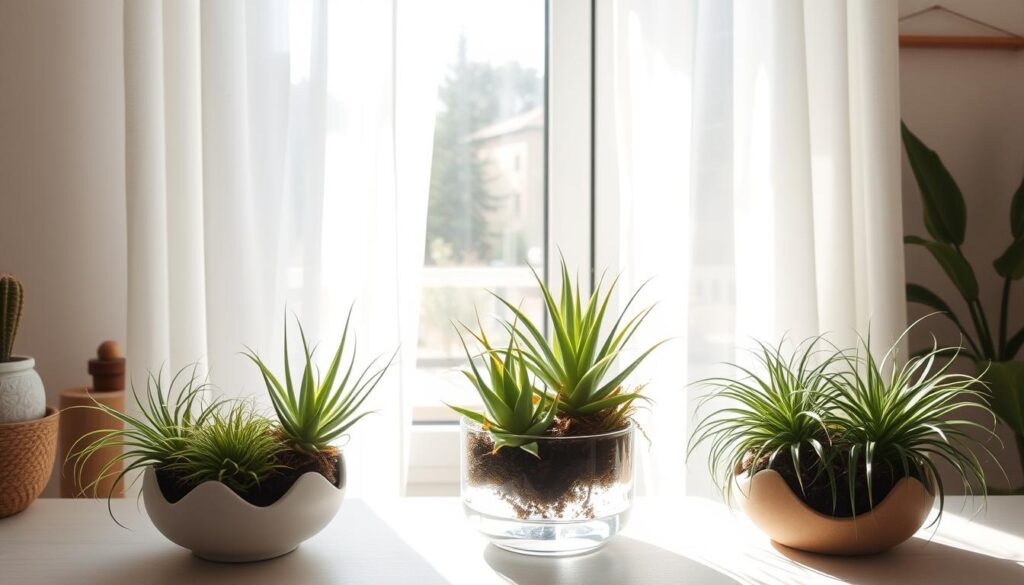
Temperature and Humidity Needs for Thriving Air Plants
Getting the right temperature and humidity is key for your air plants’ health and growth. Knowing the best conditions helps your Tillandsia thrive all year.
Optimal Temperature Ranges
Air plants like warm, temperate climates. The best temperature for most Tillandsia is between 60°F (15°C) and 85°F (29°C). Temperatures outside this range can stress them, slowing growth or even killing them.
Creating the Perfect Humidity Environment
Humidity is crucial for air plant care. Tillandsia love the high humidity of tropical places. Indoors, keep humidity between 40% and 60% to mimic their natural home. Use a humidity monitor or mister to control moisture.
Seasonal Care Adjustments
- In hot, dry months, mist and soak air plants more to keep humidity up.
- In cooler, wetter seasons, water and mist less to avoid fungal problems.
- Keep an eye on your plants and adjust temperature and humidity as needed all year.
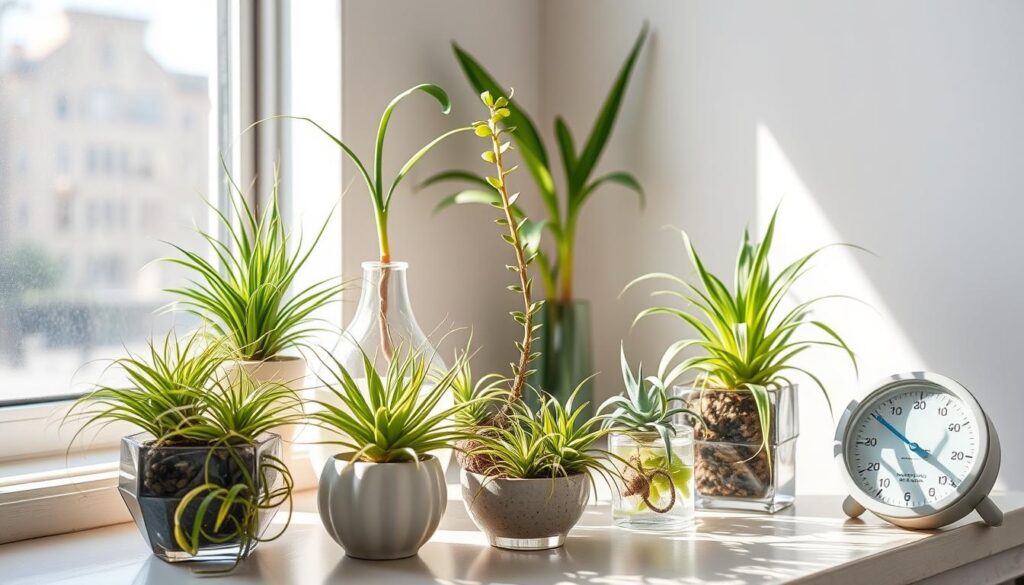
By controlling temperature and humidity, you create a great environment for your air plants. With some care, your Tillandsia will grow lush and bloom beautifully.
Fertilizing and Nutrition Guidelines
Keeping your air plants healthy and growing well is all about the right nutrition. It’s important to know how to feed them properly. This will help them flourish in your home.
Choosing the Right Fertilizer
Choosing the right fertilizer is crucial for air plants. Look for fertilizers made for air plants or bromeliads. These have the right mix of nutrients for them to grow and bloom well.
Balanced Nutrition for Healthy Air Plants
Air plants need a mix of nutrients like nitrogen, phosphorus, and potassium. They also need micronutrients like iron and magnesium. A balanced fertilizer helps them grow strong and bloom beautifully.
Fertilizing Frequency and Application
Fertilize your air plants every 2-4 weeks in spring and summer. Use half the recommended amount to avoid harming them. Mist the leaves or soak them in the fertilizer for 10-15 minutes, then rinse well.
| Fertilizer Type | Nitrogen (N) | Phosphorus (P) | Potassium (K) |
|---|---|---|---|
| Air Plant Specific | 3-5% | 3-5% | 3-5% |
| Bromeliad Fertilizer | 8-10% | 4-6% | 4-6% |
By following these guidelines, your air plants will get the nutrients they need. This will lead to healthy growth and beautiful blooms.
Common Problems and Troubleshooting
Caring for air plants, or Tillandsia, can be rewarding but comes with challenges. Owners may face diseases and pests that harm their plants. But, with the right knowledge, you can overcome these issues and keep your air plants healthy.
Disease Prevention and Treatment
Air plants can get diseases like rot and fungal infections. To prevent this, ensure proper watering, light, and air flow. Check your plants often for signs of disease, like discoloration or foul smells.
If you find a problem, isolate the plant and treat it with a fungicide or bactericide. Always follow the product’s instructions carefully.
Pest Management Strategies
Pests like mealy bugs and spider mites can be a problem. Keep your plants clean to prevent infestations. Use insecticidal soaps or neem oil to fight pests.
Regularly check your plants for pests. Act fast to stop any infestations from spreading.
Reviving Struggling Plants
Even with good care, air plants can sometimes look sick. If your plant is wilted or discolored, try changing its environment. Adjust the water or light it gets, and consider a gentle fertilizer.
With patience and the right care, you can often bring a struggling air plant back to life. It will regain its vibrant look.
Understanding common air plant problems and how to solve them is key. With the right approach, you can overcome any challenge. This way, you’ll enjoy the beauty and unique character of these fascinating plants.
Creative Display Ideas and Mounting Options
Get creative with your air plants! You can make stunning air plant displays or magical air plant terrariums. There are countless ways to show off these unique plants in your home.
Creating air plant terrariums is a great idea. They’re like tiny gardens that are both beautiful and fascinating. Pick from many containers, like glass orbs or hanging planters. Then, mix the air plants with succulents, stones, and other natural things for a beautiful look.
Try mounting your air plants on driftwood, branches, or even old books or metal frames. This adds a rustic charm to your space. It also shows off the plants’ unique growth. Play with different materials and spots to make air plant displays that are truly yours.
- Put air plants in wall hangings, wreaths, or sculptures for a lively art piece.
- Hang air plants in glass orbs or terrariums for a floating look.
- Put air plants in natural stone or wooden containers for a natural feel.
Showing off your air plants is all about letting their beauty shine. With a bit of creativity, you can turn your place into a beautiful oasis. These plants are easy to care for and truly amazing.
Propagation and Blooming Care
Learn about the amazing life cycle of air plants and how to get them to bloom. You’ll discover how to grow new plants from your existing ones. Also, find out how to care for them after they’ve bloomed.
Identifying Blooming Cycles
Air plants have a special blooming cycle. Watch your Tillandsia plants closely for a central flower spike. This means they’re getting ready to bloom.
The flower spike can be bright red, pink, lavender, or white. It makes your air plant display even more stunning.
Pup Separation Techniques
As your air plant blooms, it will grow offsets, or “pups,” at its base. These pups are crucial for growing your Tillandsia collection. Wait until the pups are about one-third the size of the parent plant.
Then, use sterilized scissors or your fingers to carefully remove the pups. Twist and pull gently, leaving a small stem attached to the pup for a successful transplant.
Post-Bloom Care
After your air plant blooms, it needs special care to keep growing. Its energy will go to the new pups, so water and fertilize less. Keep an eye on your plants, making sure they get the right light, temperature, and humidity.
FAQ
What are air plants, and how do they differ from traditional houseplants?
Air plants, or Tillandsia, are special plants that don’t need soil. They get all they need from the air and their surroundings. They thrive in dry places, unlike most houseplants.
What types of Tillandsia species are available, and how do they differ in appearance?
There are many Tillandsia species, each unique. Some are small and delicate, while others are big and sculptural. They come in different shapes and colors, with leaves that are soft or spiky.
How can I recreate the natural habitat of air plants in my home?
To make your home like their natural habitat, focus on light, water, air, and humidity. Place them in bright, indirect sunlight and ensure good air flow. Mist them often or soak them in water to keep them moist.
What are the best watering techniques for healthy air plants?
You can water air plants by misting or soaking. Mist them often for moisture, and soak them once a week for deeper hydration. Use clean, warm water and avoid standing water.
How much light do air plants need, and where should I place them in my home?
Air plants love bright, indirect light. Place them near sunny windows but not in direct sunlight. You can also use grow lights to ensure they get enough light.
What temperature and humidity levels are best for air plants?
Air plants like warm, humid places, between 60-80°F (15-27°C). Keep humidity at 40-60% by misting or using a pebble tray. Adjust care with the seasons.
How do I fertilize my air plants, and how often should I do it?
Air plants need occasional fertilizing. Use a balanced fertilizer at half-strength every 2-4 weeks during the growing season. Avoid too much to prevent damage.
How can I identify and treat common air plant problems?
Watch for fungal diseases, pests, and signs of bad watering. Isolate sick plants, remove damaged parts, and adjust care to help them recover.
What are some creative ways to display and mount air plants?
Air plants are great for creative displays. Mount them on driftwood, branches, or frames for natural looks. Use them in terrariums, planters, or hanging displays to show off their beauty.
How do I propagate air plants and encourage blooming?
Air plants grow new plants from their base. Separate these pups and let them grow their own roots. With good care, they may bloom. After blooming, focus on keeping them healthy for more growth and blooms.

